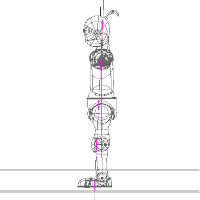Go to frame 5. Select the Line of Body. Click into Muscle mode. Select the middle point. This will be your main lever.
To see and understand: Move the middle point up and down between the pelvis and head (but not beyond). Notice that it makes no serious change in the posture of the character.
Now, move the middle
point down to about the solar plexus, and move it forward. Note that
the character's whole torso smoothly bends to match the curvature of the
spline.
For fun you can move the middle point up and down (which changes the
point at which the torso bends, but doesn't move the vertical arrangement
of the spine). Funky, eh?
However, for this
tutorial, let's keep the point in front of the solar plexus. Now
take the top point, and move it very slightly back. Note again that the
body matches the curvature of the spline fairly exactly (where possible
given the arrangement of bones).
Go to frame 15.
Select the middle point and move it back and up slightly (exhalation often
occurs higher in the chest).
Select the top
point and move it forward and slightly down.
Go to frame 20.
Select the middle point and move it back to the middle.
Select the top point and move it back where it began.
 Not a bad pay-off,
eh? Once you waded through all of that constraining, the actual animation
was disappointingly simple.
Not a bad pay-off,
eh? Once you waded through all of that constraining, the actual animation
was disappointingly simple.
This is actually much more accentuated than normal breathing would be. Typical breathing (as will be detailed in later sections of this tutorial) is so slight as to be imperceptible on the conscious level. It gets interpreted at much lower levels of perception. But, since the point of this was to let you see what the effects were, that would have been sort of pointless, wouldn't it?
So, yes, that's it. There isn't any more. That's all there is to the Dabble level breathing. Render it and show it to the list.
You're done. Move on to another tutorial.
Really, that's it.